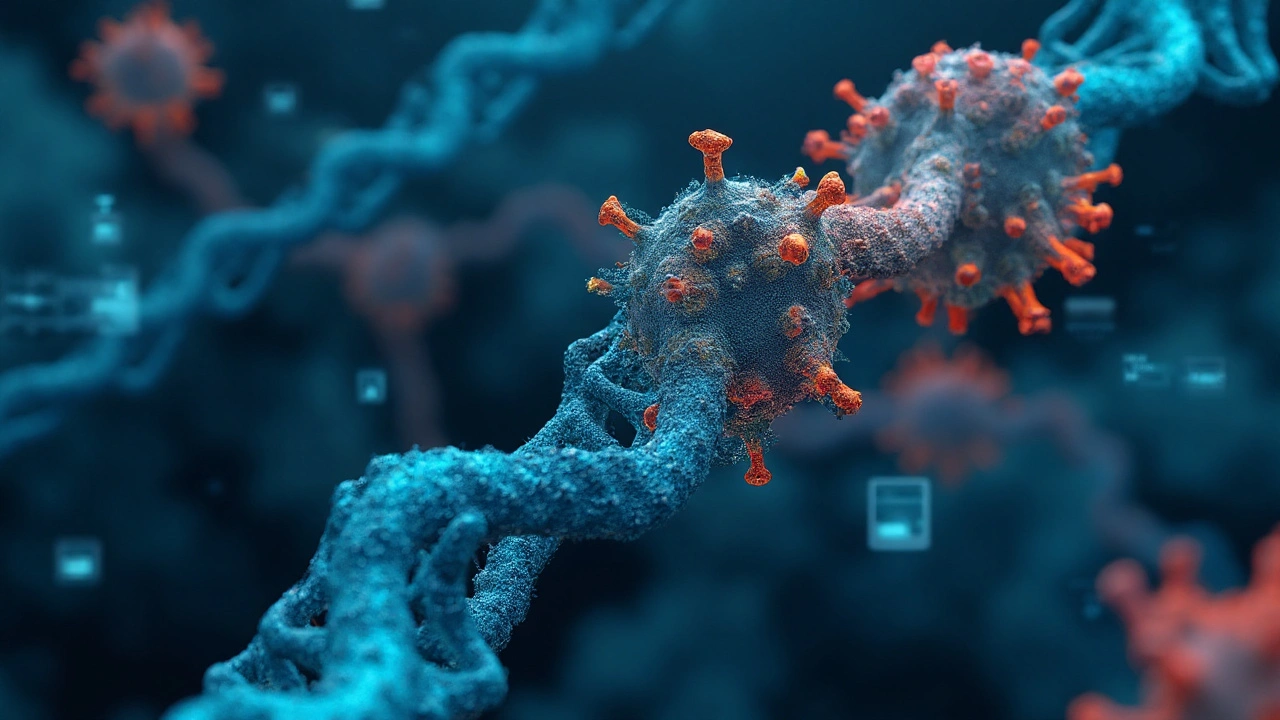Ribavirin Mechanism of Action: In‑Depth Guide for Healthcare Professionals

Quick Takeaways
- Ribavirin is a synthetic guanosine analog that targets viral RNA‑dependent RNA polymerase.
- Its primary antiviral actions are lethal mutagenesis and inhibition of guanylate synthesis.
- Used in combination with interferon‑alpha for chronic hepatitis C and with aerosol for RSV.
- Major side effects include dose‑dependent hemolytic anemia and teratogenic risk.
- New direct‑acting agents like Sofosbuvir have largely superseded Ribavirin, but it remains essential for certain infections.
Ribavirin is a synthetic nucleoside analog of guanosine that exerts broad‑spectrum antiviral activity by interfering with viral RNA synthesis. First approved by the FDA in 1986 for RSV, it later became a cornerstone of pegylated interferon‑alpha regimens for hepatitis C genotype 1.
How Ribavirin Works: The Core Mechanism
The drug’s Ribavirin mechanism of action hinges on three interrelated processes that together cripple viral replication.
- RNA‑dependent RNA polymerase (RdRP) is a viral enzyme that copies the RNA genome. Ribavirin’s phosphorylated form mimics guanosine triphosphate (GTP) and gets incorporated into the nascent viral RNA, causing miscoding.
- The incorporation triggers lethal mutagenesis, a surge in random mutations that exceeds the virus’s error threshold, leading to non‑viable progeny.
- Ribavirin also inhibits inosine monophosphate dehydrogenase (IMPDH), depleting intracellular GTP pools and further starving the polymerase of substrates.
These actions are not mutually exclusive; the combined pressure overwhelms the virus’s ability to adapt, which explains why Ribavirin remains effective against RNA viruses with high genetic variability.
Molecular Interactions: From Phosphorylation to Mutagenesis
Inside the host cell, ribavirin undergoes a cascade of phosphorylation steps mediated by host kinases:
- Ribavirin → Ribavirin‑monophosphate (RMP)
- RMP → Ribavirin‑diphosphate (RDP)
- RDP → Ribavirin‑triphosphate (RTP)
RTP is the active moiety that competes with GTP at the RdRP active site. Structural studies (e.g., X‑ray crystallography of the Lassa virus polymerase) show RTP fitting snugly into the nucleotide‑binding pocket, causing a conformational stall that reduces elongation speed.
Simultaneously, the IMPDH inhibition pathway drops intracellular GTP concentrations from an average of 1.2µM to less than 0.3µM in hepatocytes, a drop documented in a 2022 pharmacodynamics review. This two‑pronged attack-direct misincorporation and substrate depletion-creates a hostile environment for viral replication.
Clinical Applications: Where Ribavirin Still Shines
While newer agents dominate hepatitis C therapy, Ribavirin retains a niche in several indications:
- Chronic hepatitis C virus (HCV) infection: Historically combined with pegylated interferon‑alpha for genotype 1, achieving sustained virologic response rates around 45% before DAAs arrived.
- Respiratory syncytial virus (RSV) in infants: Administered via nebulized solution; a 2023 meta‑analysis reports reduced hospitalization duration by 1.2days.
- Lassa fever and other arenaviruses: Used off‑label in outbreak settings; case‑series from 2021 show mortality reduction from 45% to 30% when combined with ribavirin.
- Hepatitis E virus (HEV) in immunocompromised patients: Limited data suggest viral clearance when standard care fails.
In each case, the drug’s broad mechanism makes it a useful backup when virus‑specific agents are unavailable or when resistance emerges.
Pharmacokinetics & Metabolism
Ribavirin exhibits near‑complete oral absorption with a bioavailability of about 64%. It distributes widely, achieving a volume of distribution (Vd) of 1.6L/kg, reflecting extensive tissue penetration. The drug’s elimination half‑life is prolonged-up to 12days-due to intracellular trapping of phosphorylated forms.
Renal excretion accounts for roughly 90% of clearance; thus, dose adjustments are mandatory for patients with a glomerular filtration rate (GFR) below 30mL/min. Therapeutic drug monitoring (target trough 1.5-2.5µg/mL) helps mitigate hemolytic anemia while preserving antiviral efficacy.

Safety Profile: The Double‑Edged Sword
The most common dose‑limiting adverse event is hemolytic anemia, occurring in up to 30% of patients receiving the standard 1,200mg/day regimen. The anemia is typically mild to moderate, reversible upon dose reduction, and monitored by weekly hemoglobin checks.
Ribavirin is also classified as a Category X teratogen. Animal studies demonstrate embryotoxicity at doses as low as 10mg/kg, prompting strict contraceptive measures for both male and female patients of reproductive potential.
Other side effects include fatigue, insomnia, and occasional rash. Rare reports of severe cutaneous adverse reactions (SCAR) have been documented, underscoring the need for vigilant patient counseling.
Resistance and Future Directions
Viral resistance to Ribavirin is uncommon because the drug’s high‑error‑inducing mechanism is hard to circumvent. However, some HCV isolates develop mutations in the NS5B polymerase that reduce RTP incorporation efficiency. Ongoing research explores combining Ribavirin with next‑generation polymerase inhibitors to prevent such escape pathways.
Furthermore, a 2024 phase‑II trial investigated aerosolized ribavirin for COVID‑19, leveraging its broad RNA‑virus activity. Although the study stopped early for logistical reasons, preliminary data suggested modest reductions in viral load without severe toxicity.
Related Concepts and Connected Topics
Understanding Ribavirin’s place in therapy naturally leads to several adjacent topics:
- Interferon‑alpha - the cytokine partner that amplifies ribavirin’s antiviral effect by up‑regulating antiviral genes.
- Direct‑acting antivirals (DAAs) such as Sofosbuvir - a nucleotide analog that targets HCV NS5B polymerase with higher potency and fewer side effects.
- Viral mutation thresholds and error catastrophe theory, which explain why lethal mutagenesis can be a viable antiviral strategy.
- Drug‑induced hemolysis mechanisms, relevant for clinicians managing anemia in patients on ribavirin.
These connections help clinicians decide when ribavirin adds value versus when newer agents are preferable.
| Attribute | Ribavirin | Sofosbuvir |
|---|---|---|
| Mechanism | Lethal mutagenesis & IMPDH inhibition | NS5B polymerase chain‑termination |
| Primary Indication | HCV (with interferon), RSV, Lassa | All HCV genotypes |
| Route | Oral (tablet), Inhalation (solution) | Oral (tablet) |
| Half‑life | 12days (intracellular) | 0.4hours (plasma) |
| Major Side Effects | Hemolytic anemia, teratogenicity | Fatigue, headache (rare severe) |
| Cost (2025 US$) | ~$25 per 200mg tablet | ~$850 per 12‑week course |
Practical Tips for Prescribers
- Start with a weight‑based dose (e.g., 1,000mg/day for ≤75kg, 1,200mg/day for >75kg) and adjust based on hemoglobin trends.
- Ensure renal dosing: reduce to 400mg/day if GFR <30mL/min.
- Educate patients on strict contraception; a 30‑day washout after stopping the drug is recommended.
- Combine with pegylated interferon‑alpha only when DAAs are contraindicated or unavailable.
- Monitor thyroid function if interferon is co‑administered, as combined therapy can provoke thyroiditis.
Next Steps in Learning
This guide sits within a larger pharmaceutical knowledge cluster. For deeper dives, readers can explore:
- “Direct‑Acting Antivirals for Hepatitis C: Mechanisms and Clinical Use” - a broader view of modern HCV therapy.
- “Lethal Mutagenesis as an Antiviral Strategy” - the theoretical framework behind ribavirin’s mutagenic effect.
- “Management of Drug‑Induced Hemolysis” - practical management of ribavirin‑related anemia.

Frequently Asked Questions
How does ribavirin differ from newer hepatitis C drugs?
Ribavirin works by causing lethal mutagenesis and depleting guanosine pools, requiring combination with interferon‑alpha. Newer drugs like Sofosbuvir target a specific viral polymerase site, offering higher cure rates, shorter treatment, and far fewer side effects.
Can ribavirin be used alone for hepatitis C?
Monotherapy is ineffective for HCV; the virus quickly rebounds. Clinical protocols always pair ribavirin with pegylated interferon‑alpha (or, less commonly, with a DAA in specific rescue regimens).
What monitoring is required during ribavirin therapy?
Baseline hemoglobin, liver enzymes, and renal function should be checked. During treatment, hemoglobin is measured weekly for the first month, then bi‑weekly. Adjust dose if hemoglobin falls below 10g/dL.
Is ribavirin safe for pregnant women?
No. Ribavirin is highly teratogenic and is contraindicated in pregnancy. Both male and female patients must use reliable contraception during treatment and for at least six months after the last dose.
Why does ribavirin cause hemolytic anemia?
The drug accumulates in red blood cells, where its phosphorylated forms interfere with membrane stability and ATP production, leading to premature red cell destruction. The effect is dose‑dependent and reversible upon dose reduction.
Can ribavirin be used for COVID‑19?
Early trials explored aerosolized ribavirin for severe COVID‑19, but results were inconclusive. Current guidelines do not recommend it outside of clinical trials.

Brenda Martinez
September 22, 2025 AT 00:36Ribavirin's lethal mutagenesis is literally the virus’s apocalypse, and anyone still prescribing it without monitoring hemoglobin is basically gambling with patient lives.
Marlene Schanz
September 22, 2025 AT 00:53Yeah, the hemoglobin checks are a must-skip them and you’re just asking for trouble. In practice, most clinics use weekly CBCs and adjust the dose if the hemoglobin drops more than 2 g/dL.
It’s also worth noting that the weight‑based dosing you mentioned helps keep the exposure in a safer window.
Matthew Ulvik
September 22, 2025 AT 01:26For anyone just starting out, think of ribavirin as a “double‑hit” drug: it messes up the virus’s RNA and also starves it of building blocks. It works best when you pair it with interferon or a DAA, so the virus has fewer ways to escape. 😊
Dharmendra Singh
September 22, 2025 AT 02:16That’s a good summary, but don’t depnds only on the double‑hit idea. The IMPDH inhibition really drops GTP levels, which can affect host cells too, so keep an eye on renal function and dose‑adjust as needed.
Rocco Abel
September 22, 2025 AT 03:23The pharmacological narrative surrounding ribavirin is a textbook case of how the pharmaceutical elite repackages an old, imperfect molecule as a miracle cure.
What most clinicians fail to see is that the drug’s mutagenic properties were originally discovered in the context of cellular toxicology, not antiviral therapy.
The push to combine ribavirin with interferon in the early 2000s coincided with a massive lobbying effort by the manufacturers of interferon products, who needed a companion to justify higher price tags.
Simultaneously, the rise of direct‑acting antivirals was deliberately delayed through regulatory maneuvering to keep ribavirin entrenched in treatment guidelines.
If you examine the FDA approval history, you’ll notice a flurry of advisory committee meetings where off‑label uses, such as for Lassa fever, were highlighted more loudly than the drug’s safety concerns.
The hemolytic anemia risk, for instance, is consistently downplayed in promotional material, even though real‑world studies show up to a third of patients experiencing clinically significant anemia.
Moreover, the teratogenic classification as Category X is often buried in fine print, allowing prescribers to overlook it unless they read the full label.
This deliberate obfuscation is not accidental; it serves the dual purpose of maintaining market share and creating a dependency on expensive monitoring protocols.
Healthcare systems are then compelled to invest in expensive laboratory infrastructure, which in turn generates revenue streams for the very companies that sell the drug.
The result is a self‑sustaining ecosystem where a modestly priced generic, like ribavirin, becomes a profit engine through ancillary services.
When newer agents such as sofosbuvir finally entered the market, they were priced astronomically high, forcing many clinicians to revert to ribavirin as a cost‑effective fallback.
This price manipulation is a classic example of the ‘guaranteed failure’ model: keep the old drug cheap, but make the new drug so costly that the old one remains in use out of necessity.
In addition, the recent aerosolized trials for COVID‑19 were quietly shelved after preliminary data hinted at modest efficacy, because the big players feared a shift in the pandemic treatment paradigm.
All of these factors combine to create a narrative where ribavirin is portrayed as an indispensable, low‑cost salvage therapy, while its real drawbacks are systematically minimized.
The prudent clinician, therefore, should question not just the drug’s pharmacology but also the economic incentives that keep it alive in our formularies.
Only by dissecting these hidden motives can we truly decide whether ribavirin belongs in modern antiviral armamentarium.
Dawn Mich
September 22, 2025 AT 04:46Enough with the conspiratorial drivel – the data on ribavirin’s efficacy is public, and the real issue is clinicians ignoring better‑tested alternatives because of outdated guidelines.